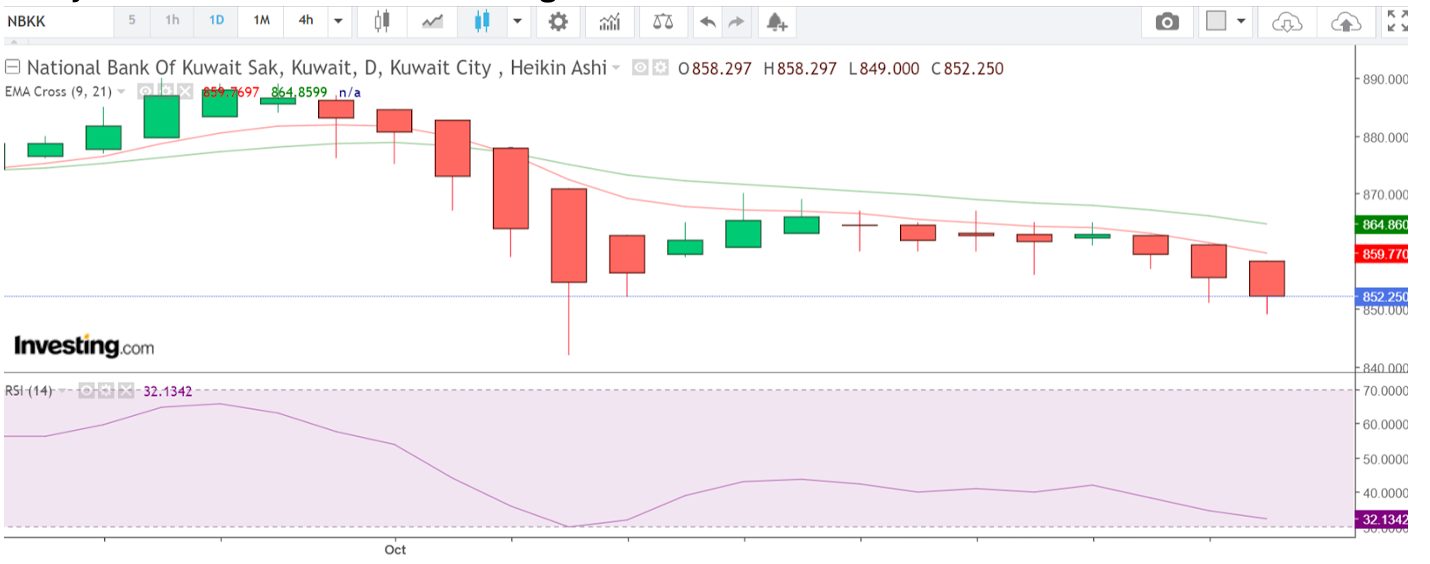CFD Trading In Kuwait



Contracts for difference (CFDs) are becoming popular with traders in Kuwait looking to speculate on everything from oil given its pivotal role in the country’s economy through to Islamic stocks and high-risk cryptos.
Use our beginner’s guide to CFD trading in Kuwait to find out how it works, the opportunities, the risks, and regulatory oversight in this bustling Middle Eastern financial hub.
Quick Introduction
- CFDs allow you to profit from the price movements of assets without buying them physically. It’s all about the difference; if you think a stock or commodity will rise, you can go long (buy). You can go short (sell) if you believe it will drop.
- All of this can be done with a relatively small initial investment due to the leverage offered by brokers, which is perfect for those wanting to amplify their potential returns.
- While leverage can make your wins feel like you’ve struck gold, it’s equally important to remember that it can magnify losses, too. That’s why risk management is essential.
- CFD trading is fully legal and regulated by Kuwait’s Capital Markets Authority (CMA), but unlike most of the world, zero tax is owed on personal trading profits.
Best CFD Brokers In Kuwait
After hands-on tests, we've found these 4 CFD trading platforms are the top options for traders in Kuwait:
How Does CFD Trading Work?
CFDs give Kuwaiti traders access to financial markets without the added expense of owning the actual assets. You can trade on margin and use the leverage offered by brokers to predict whether the price of an asset will go up or down.
Leverage lets you open larger positions but only commit a fraction of the total value (or margin) needed to buy the equivalent number of shares listed on Kuwait’s stock markets.
As an example of how leverage works, let’s discuss a potential opportunity on one of Kuwait’s leading indices, the Boursa Kuwait Main Market 50 (BK Main 50) Index.
If you’re convinced the index will rise, you could buy a CFD position in the BKM. If each contract is valued at 6,500, and your brokerage requires a 5% margin, then to take a position on 10 contracts, you’d need a margin of KWD 3,250 (6,500 per contract x 10 contracts x 5%).
If the BKM rises to 6,600, the price increase could yield KWD 100 per contract. By closing your position, you could secure a total profit of KWD 1,000 (10 contracts x KWD 100), excluding brokerage fees. But, if the index falls to 6,400, you would lose KWD 1,000.
This scenario illustrates the CFD trading risks; you can control significant size with leverage, but gains and losses are increased.
Learn how margin and leverage work, as it’s critical to your future trading success.If you are new to CFD trading, why not consider opening a demo trading account? It’s an excellent introduction to trading; you can practice strategies and build confidence before you risk your Kuwaiti dinars in the markets.
What Can I Trade?
CFDs offer many trading opportunities across several financial markets, in Kuwait, across the Middle East, and globally:
- Stock CFDs – You can trade individual stocks listed on the Boursa Kuwait stock exchange using CFDs without the added expense of buying and holding the shares. Alternatively, you could trade stock CFDs from US, European, Asian and other markets.
- Index CFDs – The Boursa Kuwait Main Market 50 (BK Main 50) Index is actively traded as a CFD. It’s a market capitalization-weighted index reflecting the top 50 liquid companies in the primary market, the Boursa Kuwait stock exchange. Traders sometimes prefer trading index CFDs to capitalize on a stock exchange’s overall market performance rather than deal in individual shares. You could also consider trading global index CFDs like the Dow Jones or NASDAQ. Liquidity is always high in these popular indices, as is the trading volume; consequently, the trading costs are very competitive.
- Forex CFDs – The Kuwaiti dinar KWD can be traded in the foreign exchange market through CFDs. Popular Kuwaiti currency pairs include USD/KWD and GBP/KWD. These exotic/minor currency pairs have some liquidity and can provide opportunities for short-term currency traders but are less widely supported and traded than majors like EUR/USD and USD/JPY.
- Commodity CFDs – Vital Middle Eastern and global commodities like gold and crude oil can traded as CFDs so that you can speculate on the price movements of these valuable resources.
- Crypto CFDs – The fascination and excitement over digital asset trading in Kuwait is similar to that of other nations. You can trade cryptocurrency CFDs like Bitcoin and Ethereum for access to the exciting but high-risk world of crypto.
Is CFD Trading Legal In Kuwait?
CFD trading is legal in Kuwait but tightly regulated to protect investors and ensure transparency in the financial markets. Let’s break it down:
The Capital Markets Authority (CMA) is Kuwait’s financial watchdog. It regulates all securities-related activities, including CFD trading. The CMA ensures that local and international brokers operating in Kuwait adhere to strict financial laws protecting traders from unfair practices, market manipulation, and fraud.
Any broker offering CFDs in Kuwait should be licensed by the CMA or other recognized regulatory bodies. This ensures these providers follow proper risk management protocols and provide transparent pricing, fair execution, and client protection.
CFD brokers catering to Kuwaiti clients often offer Sharia-compliant trading accounts, which are swap-free accounts designed for traders who want to adhere to Islamic finance principles.
These accounts allow CFD trading without the interest (swap) typically charged on positions held overnight, making them suitable for Muslim traders.
While CFDs are known for using leverage, the CMA limits the leverage available to retail traders in Kuwait. Kuwait’s regulatory framework also ensures platforms provide adequate risk warnings about the dangers of leverage.
The CMA ensures CFD brokers provide negative balance protection to retail traders. This means you cannot lose more money than deposited into your trading accounts.This protection is crucial when trading leveraged instruments like CFDs, where losses can escalate quickly if markets move unfavorably.
Is CFD Trading Taxed In Kuwait?
One significant advantage for traders in Kuwait is that there are no personal taxes, including on income or capital gains. This applies to profits from CFD trading.
Whether you’re trading in global stocks, commodities, indices, or forex through CFDs, gains are not subject to any government taxation.
This lack of capital gains tax is a significant draw for active traders in Kuwait, as it allows you to keep 100% of your profits. This is especially beneficial for CFD traders, who can trade short-term price movements without worrying about tax implications on frequent transactions.
An Example Trade
To show you how CFD trading in Kuwait works on a day-to-day basis, let’s go through a detailed example.
Bank CFDs are always a target for me to trade when looking for opportunities in unfamiliar markets because I’m used to analyzing banking performance across all markets.
In many ways, banks are a barometer of a country’s economic conditions. If bank shares rise or fall, that bullish or bearish sentiment is generally mirrored in the economy.
The drawback with trading CFD bank stocks is that they’re not exciting unless they’re suddenly subject to a takeover approach or announce disastrous or spectacular results. However, stability has advantages when considering technical analysis (TA); price is generally more predictable.
In short, TA for banks works well, most of the time.
So here, as an example of a CFD trade on a bank stock quoted on Kuwait’s stock exchange, I’m trading NBKK. The National Bank of Kuwait (NBK) is a bank in Kuwait established in 1952. NBK operates over 138 branches across 13 nations, seven of which are in the Middle East.
Fundamental Analysis
When trading a stock CFD, I always start with fundamental and then technical analysis.
When analyzing bank stocks, I’ll look for various available metrics on many investment sites. Google Finance, Yahoo Finance, and Investing.com are superb free resources for researching the fundamentals of a specific stock.
For banks like NBKK, I focus on metrics such as market capitalization, EPS (earnings per share), P/E ratio, net revenue, one-year stock price change, and the 52-week range.
I’ll also scour financial newswires for sentiment readings, and in this instance, the overwhelming analyst recommendation was a strong sell.
Technical Analysis
My screening software flagged this stock as a sell early in the month. Although I’m primarily a day trader of indices and currency pairs, I will swing trade stocks, using higher timeframes like the daily (D1), if the parameters my screening service generates ping me a signal.
I minimize the use of day trading indicators for my technical analysis, relying on one from each of the four key groups: momentum, trend, oversold and overbought, and volatility.
I support my selection with candlestick formation and price action analysis, which Heikin Ashi best illustrates. In this instance, I only applied the RSI and EMA crossover as a strategy to execute, monitor and manage the trade.

The price action displayed on the D1 timeframe breaks down into three distinct periods:
- A bearish downtrend
- Ranging conditions
- A re-continuation of the bearish sell-off
My alert to go short occurred when the two EMAs, with settings of 9 and 21, crossed and the RSI (on its standard setting of 15) crossed the median 50 level in a downward trend. My analysis of the candlestick patterns/price-action supported my reading of the technical indicators.
At the start of the downtrend, as shown by the Doji, we see indecision and a balance between buyers and sellers. Then, we see the first bearish candle formed by an inverted hammer. A textbook three-solders pattern follows this; each candle formed is bigger, reaffirming the overwhelmingly bearish sentiment.
In the next period, we see ranging conditions, which are not uncommon after a sharp sell-off. But critically, the EMAs do not narrow or cross, so I have no reason to close the currently open trade.
I entered at 871, and my stop-loss order was initially placed at 883, the closing price of the bearish, inverted hammer candle. However, as the picture changed, I moved my stop to 862, so the trade is currently in guaranteed profit.I took this trade in the market using a CFD. I effectively traded the equivalent of 10 contracts through my broker. My required margin was 20%. At KWD 871 x 10 x 20, the margin needed was KWD 1,742.
Bottom Line
CFD trading in Kuwait presents a fairly unique opportunity for traders to access global markets without the burden of capital gains or income taxes.
With a well-regulated environment overseen by the Capital Markets Authority (CMA), traders can enjoy the benefits of leverage, flexibility, and the ability to profit from rising and falling markets.
However, it’s crucial to choose a reliable, regulated broker and understand the costs associated with trading, such as spreads and commissions. Also, only risk what you can afford to lose.
To get going, turn to DayTrading.com’s pick of the best CFD day trading platforms.
Recommended Reading
Article Sources
- Boursa Kuwait Stock Exchange
- BKM - Investing.com
- Kuwaiti dinar KWD - Trading Economics
- Capital Markets Authority (CMA)
- Sharia-compliant (Islamic) - Alrayan Bank
- NBKK - Investing.com
- Google Finance
- Yahoo Finance
- Stockopedia Screening Software.
The writing and editorial team at DayTrading.com use credible sources to support their work. These include government agencies, white papers, research institutes, and engagement with industry professionals. Content is written free from bias and is fact-checked where appropriate. Learn more about why you can trust DayTrading.com



